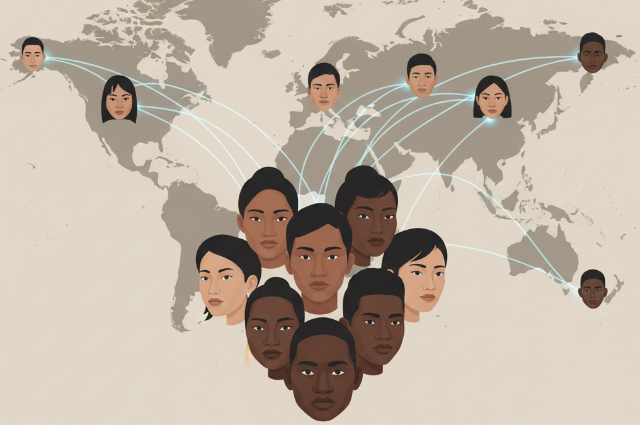
Evolutionary geography is an exciting interdisciplinary region such as bridges genetics, archeology, paleoecology, and geophysics to unveil the wonderful story of homo sapiens migration routes around the world. The last decades of technological progression, from ancient DNA sequencing to GIS-based spatial modeling-enlightened old routes and countless forces that have shaped humanity’s geographical journey. The story uses findings and data analysis in the Savannah scenario in Africa to Tiera del Fuego’s Windswept Hills, who re -defines our origin with detailed details.
Anthropologists and geneticists largely agreed that the story begins in Africa, where early Homo Sapiens developed around 200,000 years ago. Fossil proof, as Omo Kibish, remains in Ethiopia, and Jebel Irhoud fossil in Morocco provides a physical anchor for these claims, reflecting the origin of our species in the African continent. Understanding how and when scattered people from Africa are made possible through the technical analysis of genetic markers. Mitochondrial DNA and Y-chromosome-haplogroups, which act as molecular time clocks, allow researchers to estimate the time of divergence and detect the offspring on continents.
70,000 and 100,000 years ago, the first important waves left Homo Sapiens left Africa, partly practical to climate change, making new areas available. Two major migration corridors have emerged from multidisciplinary research. The first route reached the Sinai Peninsula and the Levant in West Asia. Archaeological finds indicate that those at the Qafzeh cave in Israel were around 120,000-100,000 years ago for this northern migration. Meanwhile, a southern coastal route began in the Bab-el-Mandeb-Strait- a narrow bridge because of the lower level of the sea-one lower bridge-as people entered the Arabic Indian subcontinent and eventually entered Southeast Asia. Striking, stones similarities in places like Jebel Faya (UAE) and Jwalapuram (India) connect these remote places to the traditions of Africa, which provide specific evidence of the associated population.
Technological progress in radio dating and paleogenomics has accelerated these migration maps. In the Zhiren Cave and the Liujiang region in South China, human controversial are dated as far as it is back as 139,000 years, suggesting frequent or expanded migration. The teeth found in Lunadong in Guangxi indicate that modern people had arrived in East Asia at least 126,000 years ago. The entire genome sequencing enables researchers to compare a diverse population, identify complex migration material, and identify entrance, which Homo Sapiens has differentiated with its trails with Neanderthals and Denisovans, which still exists in the modern Eurasian population.
Environmental pressures such as aridification, glaciation cycles, and the quest for reliable food sources decisively shaped migratory choices. The “Coastal Dispersion Theory” contends that humans rapidly advanced along shorelines, exploiting marine resources and warm climates. For example, research on the DNA of Malaysia’s Orang Asli indicates their ancestors traversed the Indian Ocean coastline around 65,000 years ago, eventually reaching Australia—the earliest unequivocal evidence for humans there dates to roughly 65,000 years before present, from the Madjedbebe rock shelter.
Yet, inland migration routes present an equally compelling narrative, backed by archaeological sites in Gujarat’s Saurashtra Peninsula. Here, Middle Paleolithic stone tools found in the Bhadar and Aji river basins, dated to 56,000–48,000 years ago, suggest advanced terrestrial movement. The absence of marine resource remains such as shells and fish bones reinforces a model of interior dispersal, following rivers and exploiting terrestrial habitats�. These findings challenge sea-centric models and highlight flexibility in migration patterns.
When man was distorted in Eurasia, their population was diverse. NTU Singapore charts from the longest prehistoric visit of humanity from new technical studies: a 20,000 km Trek from North Asia, now in snow bridges, and Tiera del Fuego in Argentina to the south. By comparing shared genetic variants and mapping the accumulation in millennia, this panoramic research reconstructs how people overcome the extremes – tundras, mountains, and deserts – and are divided into ancestors’ groups that are now recognized as original Americans and other global groups.
A luxurious discovery appeared from Siberia, where DNA from a bone revealed that the person was a Denisovan father and a Neanderthal mother’s child, who was ready to mingle among different human groups because they met and existed. Genetic studies now confirm that modern European and Middle Eastern populations have 1-4% nineteen DNA, which is a result of these migrations during migration.
In Oceania, migration paints another living tableau. America’s disposal – when it was assumed that it was only 15,000 years ago – it was recently been reduced. Genomic analysis of the skeleton in North and South America indicates many migration events, arriving the leading group arriving 20,000 years ago through Beringia, an ice-edge land bridge connecting Siberia to Alaska. These arrivals formed an isolated basic population, whose genetic signatures remain in today’s indigenous groups.
Tracking these routes has become increasingly accurate through satellite mapping, gearing analysis, and calculation modeling. Environmental construction, using old pollen and isotope analysis, reveals the changing climate and biomes that met migrants, and provided clues as to why some corridors flourished while others remained inaccessible. For example, the river valleys and wetlands attracted the migrant band, which provided hunting areas, water, and niche houses for existence and expansion.
The technology of developing geography highlights new mysteries. The entire genome sequencing not only allows detailed reconstruction of the routes, but also identification of genetic adaptation as resistance to cold in the Arctic population, or lactose tolerance in rustic groups, reflecting diets with migration paths and environmental changes. Today’s molecular anthropology projects, such as Genomeasia100K, integrate thousands of individual genomes from different ethnic groups and offer outstanding resolution of migration time, occurrence of deviations, and genetic exchange.
In modern times, these ancient migration echoes in current human movements, although war is inspired by economic demands rather than by wars, climate change, and environmental concerns. The modern routes, such as the central Mediterranean corridor and the so-called South-West Asian route, reflect a continuous difference between the landscape, existence, and adaptation, which have shaped Homo sapiens throughout history.
References –
